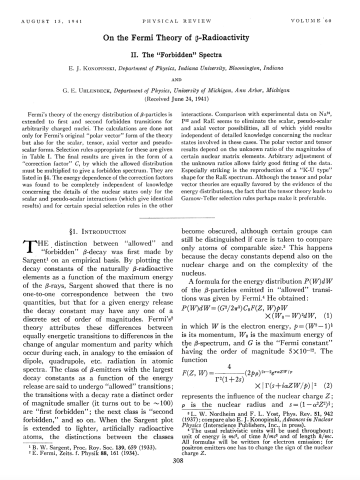On the Fermi Theory of Beta Radioactivity II: The “Forbidden” Spectra

Fermi's theory of the energy distribution of β-particles is extended to first and second forbidden transitions for arbitrarily charged nuclei. The calculations are done not only for Fermi's original "polar vector" form of the theory but also for the scalar, tensor, axial vector and pseudoscalar forms. Selection rules appropriate for these are given in Table I. The final results are given in the form of a "correction factor" C, by which the allowed distribution must be multiplied to give a forbidden spectrum. They are listed in §4. The energy dependence of the correction factors was found to be completely independent of knowledge concerning the details of the nuclear states only for the scalar and pseudo-scalar interactions (which give identical results) and for certain special selection rules in the other interactions. Comparison with experimental data on Na24, P32 and RaE seems to eliminate the scalar, pseudo-scalar and axial vector possibilities, all of which yield results independent of detailed knowledge concerning the nuclear states involved in these cases. The polar vector and tensor results depend on the unknown ratio of the magnitudes of certain nuclear matrix elements. Arbitrary adjustment of the unknown ratios allows fairly good fitting of the data. Especially striking is the reproduction of a "K-U type" shape for the RaE spectrum. Although the tensor and polar vector theories are equally favored by the evidence of the energy distributions, the fact that the tensor theory leads to Gamow-Teller selection rules perhaps make it preferable.